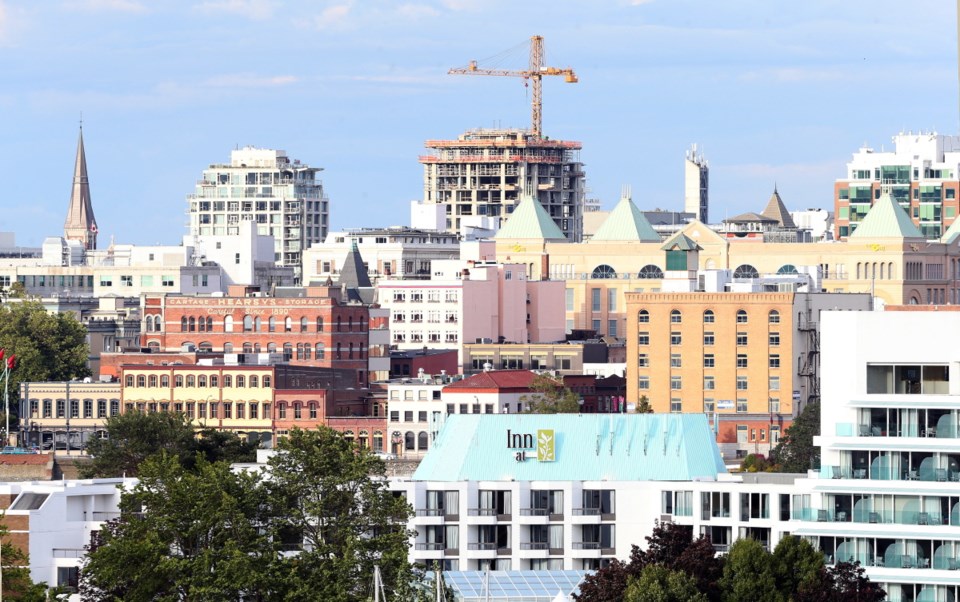You needn’t have lived in Victoria during the 1970s to recognize that that era pretty much passed the region by, architecturally speaking. Although the city core sports signs of the period — those few high-rise office bunkers stand out amidst the heritage buildings — overall, Victoria’s skyline survived the bulldoze-and-rebuild decade unscathed.
We are fortunate. Some people — those who disdainfully pan any architectural style that developed mid-century or thereafter — might say we’re blessed.
Other Canadian cities fared less well. The ’70s race toward the future saw heritage buildings elsewhere razed. In many cities, streets of 19th-century low- and mid-rise structures built of sandstone or brick and dressed up with carvings and character became, first, piles of rubble and dust, then sites of sky-high symbols of corporate achievement.
I’m told the architectural charm found today in pockets of Vancouver’s West End characterized much of the downtown area through the 1960s. Old photos of Calgary show elegant low-rise sandstone storefronts typical of parts of today’s Eighth Avenue throughout that city’s (much smaller) core. And only a few celebrated examples of Toronto’s built heritage remain standing in the shadows of that city’s skyscrapers.
Those cities sit at crossroads of commerce. The communities were built at rail and maritime terminuses, where the seams of shipping and transportation meet, where goods and people collect like lint to await passage to points beyond, and where progress treadles inexorably along. Those cities attracted opportunity, and grew — and grew — accordingly.
Sleepy Victoria had the advantage of being an island city. Despite early 20th-century boosterism and government lobbying, it would never really be the end of the rail line. Even iconic Canadian Pacific eventually conceded that starting coastal and ocean-going liners from the Lower Mainland made better business sense than requiring passengers to book an additional, entire day of travel to or from Victoria.
For much of modern history, the moat surrounding Vancouver Island stemmed the invasion by head offices. It also kept the population low and the pace slow. Favoured destination of honeymooners and old-age pensioners, it was too isolated, too quiet and too small for non-government movers, shakers and career-minded corporate-ladder climbers.
Besides, that island problem was, well, problematic. Air travel was expensive. And for decades, recurring threats of ferry strikes prompted many people to avoid the Island.
But time and technology have caught Victoria up. The Internet and its associated communications advances have diminished physical barriers and stitched the world tightly together. It’s now possible to live in Victoria, yet work for companies in Seattle, California, Vancouver, Toronto or further afield. It’s also possible to live elsewhere and maintain a daily working high-speed, virtual presence here.
The city’s proximity to Seattle and Vancouver caught the attention of software developers, with the tech sector quietly emerging as the region’s Great White Hope. For more than a decade now, families with school-aged children moving to Victoria have outnumbered incoming retirees.
And now, with the U.S. economy picking up, China’s crackdown on corruption and tanking economy, low interest rates and wide-open loopholes in real-estate regulations have made B.C. an attractive investment. In the Lower Mainland, a rundown house on a nondescript Burnaby lot now sells for almost $2 million. Four-year-old luxury homes in swish Point Grey are bought on the understanding that they will be quickly replaced with even bigger, even more luxurious houses. Affordable rental housing throughout the region is quickly being replaced with unaffordable condo towers that make no allowances for families or fixed incomes.
Despite modern technology, Victoria’s island status has, to date, buffered it from the outright craziness that afflicts mainland real estate. As well, the debates that were triggered by the development of the Eaton Centre (now Bay Centre) in the late 1980s addressed local heritage preservation.
Hard-fought battles to recognize the community’s heritage resources resulted in a community plan that safeguards the historic character of Old Town and permits new, higher-density development to the east and north.
It’s unlikely, with technology and travel advances helping to bridge the island moat, that the coming decade will pass Victoria by completely.
However, although Victoria’s skyline is changing and modernizing, those decades-old decisions will help to keep the city from being turned into a Gotham-like grid of skyscraper canyons and condo towers.



